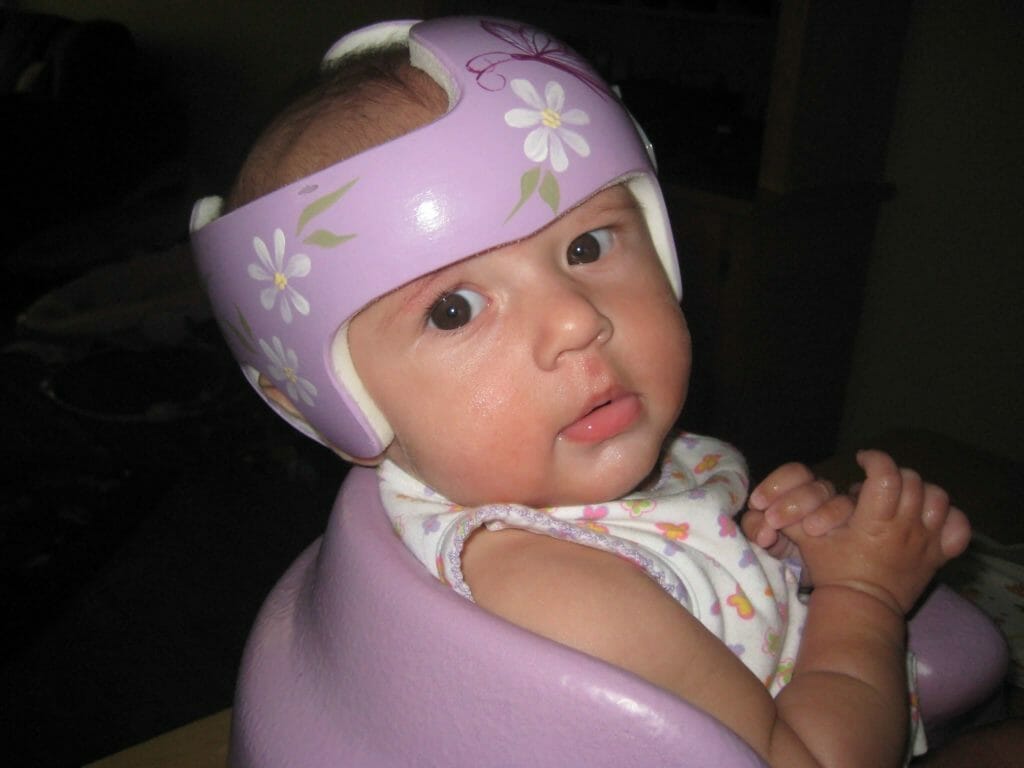As your new baby enters the world and develops, your eyes are locked in on their every move, smile, and coo. You get a front-row seat into their development, and as they develop you may be noticing changes in their head shape, and you may be wondering, “Is this normal?” or “Will this go away?” You may have noticed this right after they were born and are not seeing improvements, or you may not have noticed it at all and a friend pointed it out. Whatever the reason, you’re once again left wondering, “Is there something wrong?” If you are noticing increased flattening of any area on your baby’s head, your baby might be exhibiting Plagiocephaly.
What is Plagiocephaly and how do I know if my baby has it?
“Plagiocephaly” is a term for asymmetry of the head caused by flattening that can occur due to the baby’s positional needs and preferences (Hanger Clinic, 2021). The bones in your baby’s head are soft and malleable for the first 1.5 years of life, and this is necessary not only for the initial birthing process (allows them to squeeze through the birth canal) but also to allow for the rapid brain growth and development that occurs early on. Plagiocephaly most commonly results in flatness on one side of the back of a baby’s head, and can also result in a term called “bossing,” which refers to a protrusion of the frontal area of a baby’s head on the same side creating a parallelogram shape (Van Vlimmeren, 2008). It is important to note that plagiocephaly is commonly seen in combination with torticollis, which is tightening of the neck muscles on one side. In a baby with torticollis, their tight muscles pull them into a position of the ear toward the shoulder on their tight side (lateral flexion) and turning of their head to the opposite side (cervical rotation).

When a baby with torticollis spends prolonged time in their preferred position while sleeping or in their car seat, it can place pressure on a localized area of their head and lead to flattening. For example, a baby with right-sided torticollis (more common than left, although we don’t know why!) may also exhibit left-sided plagiocephaly or a flat spot on the back left area of their head. However, torticollis is not the only cause of flattening. Other causes include intrauterine constraint, premature birth, primiparity (first child), prolonged second-stage labor, multiple gestations, prolonged positioning in the NICU, preferred sleeping position, too much time on their back, insufficient tummy time, or too much time in “containers” such as car seats, bouncers, baby swings, and strollers (Pan, 2017; Wilbrand, 2012; Rodgers 2011; Littlefield, 1999).
These areas of flatness on your baby’s head can emerge in different locations, but the typical presentations are grouped into three categories:
- Plagiocephaly: flattening on one side of the back of a baby’s head; can result in a parallelogram shape to a baby’s head.
- Bracycephaly: This form typically results in flattening on both sides of the back of a baby’s head. The head is then wider than its length.
- Scaphocephaly: This form results in flattening on both sides of the baby’s head, where the head has a long and narrow shape.
How is it treated?
Be sure to voice your concerns to your pediatrician, and should your concerns persist, be persistent in advocating for an evaluation! An occupational therapist or physical therapist trained in this specialty area of treatment will assess your child to determine the form of plagiocephaly based on their clinical presentation including assessing for severity, the presence of co-occurring facial asymmetries, and whether there is neck involvement (otherwise known as torticollis, as mentioned above). The therapist will also assess for any other clinical symptoms that may result in differential diagnoses. They will guide you through a plan of action including hands-on techniques, environmental modifications, and positioning to help reduce the flattening and improve your baby’s head shape, including offering any referrals that may be indicated. If your child has both plagiocephaly and torticollis, your therapist will treat both simultaneously.
In some cases, your baby may benefit from a “helmet” – otherwise known as cranial remodeling orthoses – for a period of time to assist with allowing the head to grow. The ideal time frame to have your baby fitted for a helmet is during four to seven months of age, and this treatment approach is time-sensitive and can only be utilized up to 18 months of age (Lennartsson, 2011). Delayed treatment of initiating a helmet can significantly impact treatment outcomes (Kluba, 2011). Duration of treatment for the cranial orthoses is dependent on a multitude of factors, including age, severity, and comorbidities such as torticollis. Should your child be prescribed a helmet, your orthodontist will provide you with a gradually increasing wear schedule that may start slow, to the child’s tolerance, and eventually work up to a “full wear schedule” of 23 hours per day, 7 days per week (Hanger Clinic, 2021).
Craniosynostosis vs Plagiocephaly
It is important to emphasize that plagiocephaly is not the only cause of asymmetries in a baby’s head. When we are born, we have five main bones in a newborn skull. These bones are joined by fibrous sutures that allow for the skull to grow as the brain grows simultaneously (Miles, 2021).
A condition called Craniosynostosis which is a birth defect that causes a premature fusion of the cranial sutures and bones in a baby’s skull may also be a cause of misshaping of the skull (CDC, 2021). The type of craniosynostosis is dependent upon what sutures in the brain join too soon, and may require surgery to correct (CDC, 2021). If your therapist has concerns over your baby possibly having craniosynostosis, they will refer you out to the appropriate provider to rule out this differential diagnosis.
What can I do at home to reduce the effects of Plagiocephaly?
Your therapist will provide strategies on how you can change the environment around your baby and your baby’s positioning throughout the day to reduce the effects of Plagiocephaly depending on the type. Below are some quick tips:
- Whenever possible, limit the amount of time your baby spends in their car seat to just travel.
- Limit the amount of time your baby spends in any container or carrier (infant swings, infant carriers, car seats, strollers, infant/toddler rockers) to 10-15 minutes maximum and no more than 1-2 times a day. If the child needs to be in a carrier, ensure that their head is positioned at midline.
- ALWAYS keep your baby’s head off of their flat spot during all awake and supervised times. We want to prevent more pressure on the flat spot. Remember, that any surface the baby’s head is resting on can cause pressure and make the flat spot worse.
- Try to integrate all stretching, strengthening, and positioning into your daily routine to help with forming good habits.
- Increase supervised and awake tummy time play to five times a day for 5-10 minutes and build upon that.
(Miles, 2021). If you or someone you know has concerns about their child, please contact KidSense Therapy Group and schedule an evaluation. Given that Plagiocephaly can influence and be influenced by Torticollis we recommend you check out our recent blog addressing tips and strategies on Torticollis!
Recommended Reading:
References
Centers for Disease Control and Prevention (2021). Facts about craniosynostosis. Retrieved
from https://www.cdc.gov/ncbddd/birthdefects/craniosynostosis.html.
Cranial Technologies. (2021). What is plagiocephaly? Retrieved from
https://www.cranialtech.com/plagiocephaly/what-is-plagiocephaly/.
Hanger Clinic (2021). Plagiocephaly. Retrieved from: https://hangerclinic.com/pediatrics/orthotics/cranial-helmets/plagiocephaly/.
Kluba S., Kraut W. et al. (2011). What is the optimal time to start helmet therapy in positional plagiocephaly. Plast Recon- str Surg. 128(2):492-8.
Lennartsson, F. (2011). Testing guidelines for child health care nurses to prevent nonsynostotic plagiocephaly: a Swedish pilot study 12. Journal of Pediatric Nursing. 26(6):541-551.
Littlefield, T. R., Beals, S. P., Manwaring, K. H., et al: (1998). Treatment of craniofacial asymmetry with dynamic orthotic cranioplasty. J Craniofac Surg. 9: 11-19.
Miles, C. (2021, April, 19,20,26,27). Torticollis: Assessment & treatment of infants & children – “Impact on the movement system of infants & beyond” [Live webinar]. Education Resources.
Pan, W. W., Tong X. M.(2017). A clinical analysis of 101 infants with plagiocephaly. 19(10): 1061-1065.
Rogers, G. F. (2011). Deformational plagiocephaly, brachycephaly, and scaphocephaly. Part II: Prevention and treatment. J Craniofac Surg. 22(1): 117-23.
van Vlimmeren, L. A., van der Graaf Y., Boere-Boonekamp, M. M., L’Hoir, M. P., Helders, P. J., Engelbert, R. H. Effect of pediatric physical therapy on deformational plagiocephaly in children with positional preference: A randomized controlled trial. Arch Pediatr Adolesc Med. 2008;162(8):712-8.
Wilbrand, J.F., Schmidtberg, K., Bierther, U., Streckbein, P., Pons-Kuehnemann, J., Christophis,P., Hahn, A., Schaaf, H., Howaldt, H. P. (2012). Clinical classification of infant nonsynostotic cranial deformity. J Pediatr. 161(6):1120-5.

